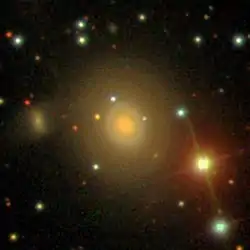| NGC 7053 | |
|---|---|
 SDSS image of NGC 7053. | |
| Observation data (J2000 epoch) | |
| Constellation | Pegasus |
| Right ascension | 21h 21m 07.6s[1] |
| Declination | 23° 05′ 05″[1] |
| Redshift | 0.015704 |
| Heliocentric radial velocity | 4,708 km/s[1] |
| Distance | 195.6 Mly |
| Apparent magnitude (V) | 14.02[1] |
| Characteristics | |
| Type | S? [1] |
| Size | ~101,420 ly (estimated)[1] |
| Apparent size (V) | 1.4 x 1.3[1] |
| Other designations | |
| 2ZW 124, CGCG 471-8, IRAS 21188+2252, MCG 4-50-9, NPM1G +22.0620, PGC 66610, UGC 11727[1] | |
NGC 7053 is a spiral galaxy located about 200 million light-years away in the constellation of Pegasus.[2][3] It was discovered by astronomer Albert Marth on September 2, 1863. It was then rediscovered by astronomer Heinrich d'Arrest on October 8, 1865.[4]
Tow supernovae have been observed in NGC 7053. On 4 June, 2003, SN 2003ep (type Ia, mag. 15.7) was discovered.[5] On 28 July, 2022, SN 2022pux (type II, mag. 17.9) was discovered.[6]
See also
References
- 1 2 3 4 5 6 7 8 "NASA/IPAC Extragalactic Database". Results for NGC 7053. Retrieved 2017-07-01.
- ↑ Rojas, Sebastián García. "Galaxy NGC 7053 - Galaxy in Pegasus Constellation · Deep Sky Objects Browser". DSO Browser. Retrieved 2017-07-02.
- ↑ "Your NED Search Results". ned.ipac.caltech.edu. Retrieved 2017-07-02.
- ↑ "New General Catalog Objects: NGC 7050 - 7099". cseligman.com. Retrieved 2017-07-01.
- ↑ "IAUC 8141: 2003ew, 2003ex, 2003ey,, 2003ez; N IN NGC 6822; 2003ep". www.cbat.eps.harvard.edu. Retrieved 2017-07-02.
- ↑ Transient Name Server entry for SN 2022pux. Retrieved 24 March 2023.
External links
- NGC 7053 on WikiSky: DSS2, SDSS, GALEX, IRAS, Hydrogen α, X-Ray, Astrophoto, Sky Map, Articles and images
This article is issued from Wikipedia. The text is licensed under Creative Commons - Attribution - Sharealike. Additional terms may apply for the media files.